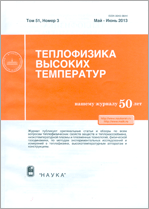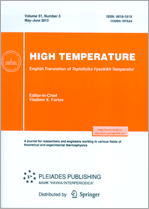|
|
Teplofizika vysokikh temperatur, 2000, Volume 38, Issue 2, Pages 321–334
(Mi tvt2079)
|
 |
|
 |
This article is cited in 15 scientific papers (total in 15 papers)
Reviews
Current status and potentialities of wind tunnels with MHD acceleration
V. I. Alfyorov
Central Aerohydrodynamic Institute, Zhukovskii
Abstract:
The activities aimed at development of hypersonic wind tunnels with MHD gas accelerator started in the late 1950s, when it became clear that the uses of hypersonic wind tunnels of the classical type employing the principle of adiabatic expansion for gas acceleration are subject to limitations. A flow train was developed for such a wind tunnel including a source of conducting gas (electric-arc heater, region behind the reflected shock wave, high-pressure chamber of an impulse wind tunnel, etc.), a system for delivery of readily ionizing seed ($\mathrm{K}$, $\mathrm{Na}$, $\mathrm{Cs}$, and their compounds), a primary supersonic nozzle with a Mach number $\mathrm{M}\simeq1.6-3.0$, the MHD-accelerator channel proper, the working section, and a gas exhaust system. In the United States, these studies were performed at the NASA Langley Center, AEDC, and General Electric; in Russia, at the Central Institute of Aerohydrodynamics (TsAGI). Some work was done in France at ONERA and in Germany. This review contains an analysis of various design solutions of the MHD channel proper, seed delivery systems, and systems of electric supply and magnetic field generation, as well as a comparison of the procedures for testing and acquisition and treatment of experimental data. Special note is made of the difficulties confronting the researchers and of the reasons for simultaneous cessation of research activities in the United States at almost all research centers. It is indicated that in Russia, unlike the United States, much more extensive studies were made into the physics of combustion of discharge in gas flows at Mach numbers $\mathrm{M}=0-4.5$ both with and without a magnetic field. Data are given on the behavior of current distribution in the electrodes, propagation of microarc discharges, boundary layer separation, and magnitude of heat fluxes with the flow parameters corresponding to those of the MHD accelerator. The basic characteristics of the TsAGI hypersonic wind tunnel are given along with the results of its utilization for solving practical problems of aerodynamics. Results are also given of the investigation of a high-enthalpy MHD generator in which the flow from the MHD accelerator is used as the working medium. The advantages are demonstrated of using facilities with MHD gas accelerator in solving the problems of development and testing of scramjet engines (SJE) for transatmospheric flying vehicles, and information is given about the possible parameters (gasdynamic and electrodynamic) of such facilities and their designs. The main problems are listed that must be solved in developing hypersonic facilities with MHD gas accelerator.
Received: 02.04.1998
Citation:
V. I. Alfyorov, “Current status and potentialities of wind tunnels with MHD acceleration”, TVT, 38:2 (2000), 321–334; High Temperature, 38:2 (2000), 300–313
Linking options:
https://www.mathnet.ru/eng/tvt2079 https://www.mathnet.ru/eng/tvt/v38/i2/p321
|


|





 Contact us:
Contact us: Terms of Use
Terms of Use
 Registration to the website
Registration to the website Logotypes
Logotypes








 Citation in format
Citation in format 
